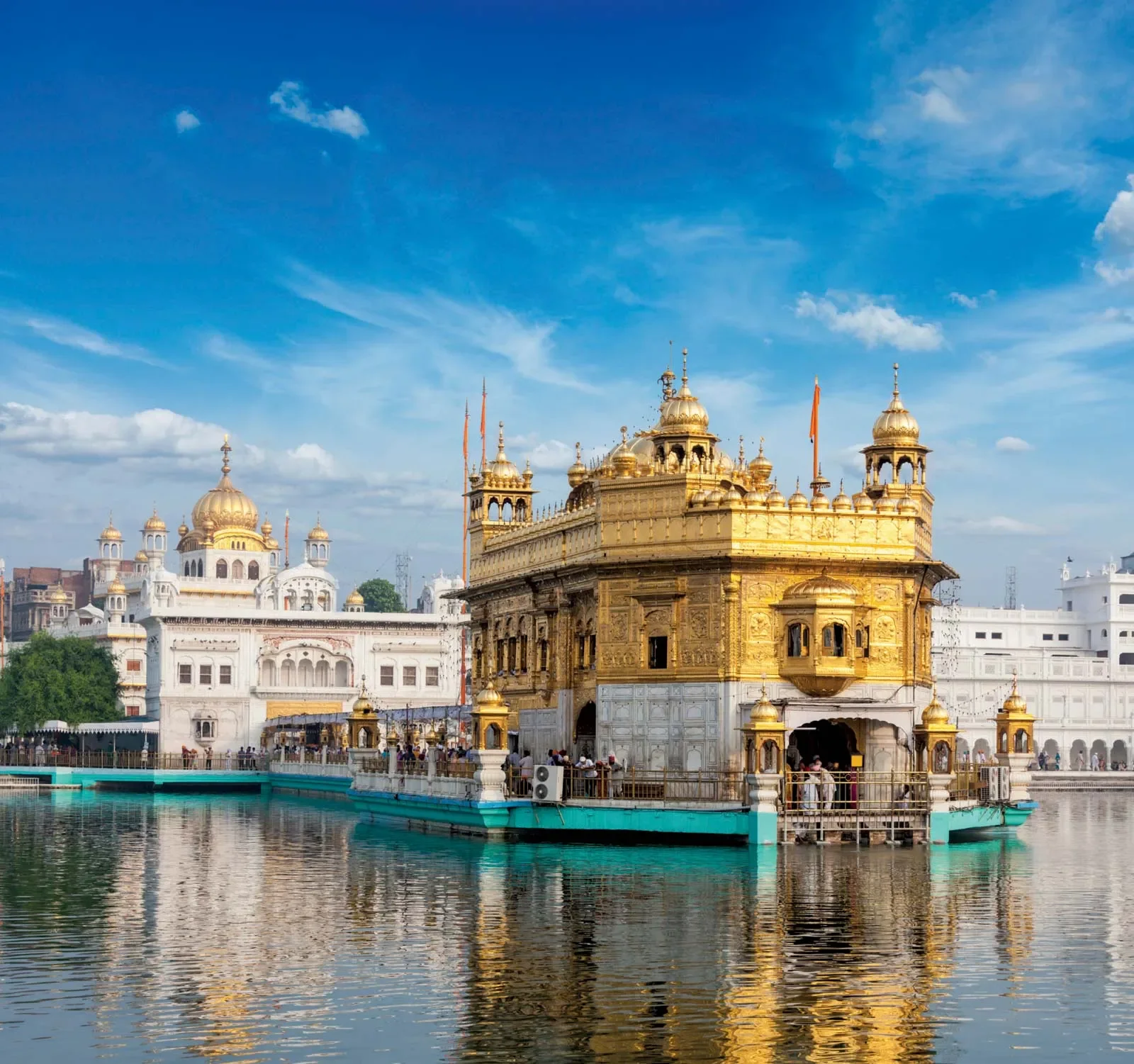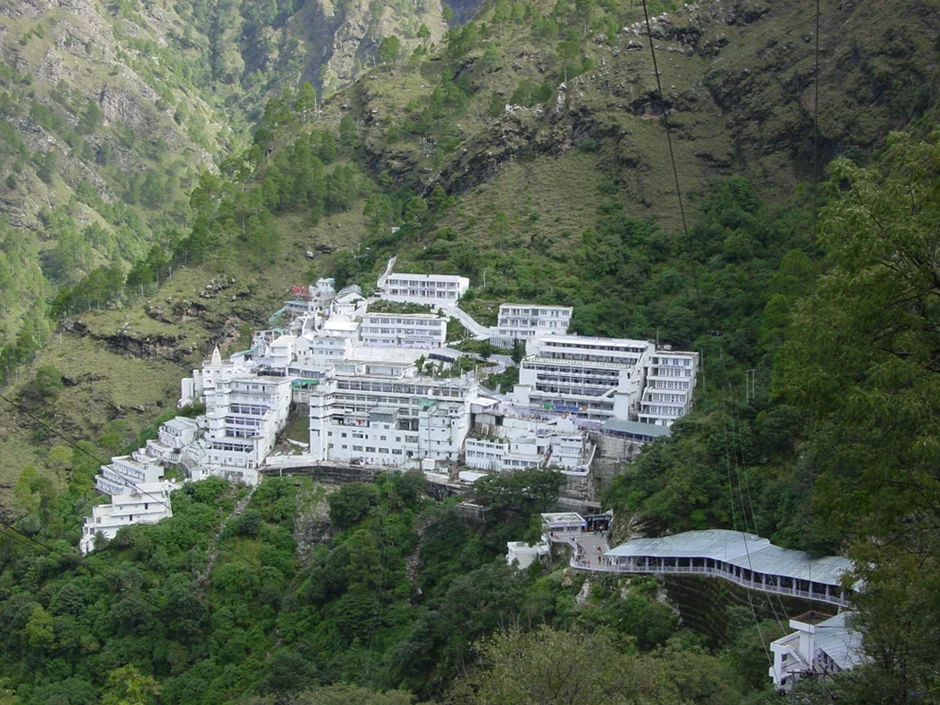India, a land known for its rich cultural heritage and diversity, is home to some of the world’s most magnificent temples. These temples stand as a testament to the country’s spirituality, architecture, and history, drawing millions of devotees and tourists from all corners of the globe. In this blog, we will embark on a spiritual journey to explore the top 5 famous temples in India.
1. The Golden Temple, Amritsar:

The Golden Temple, also known as Sri Harmandir Sahib, is the most iconic and revered shrine for Sikhs. Located in Amritsar, Punjab, this temple is a breathtaking sight with its stunning golden façade that reflects in the sacred Amrit Sarovar (Pool of Nectar) that surrounds it. The Sikhs all over the world, daily wish to pay a visit to Sri Amritsar and to pay their respects and tribute at Sri Harmandir Sahib in their Ardas.
The Golden Temple in Amritsar shines not only with its golden façade but also with the principles of Sikhism, emphasizing selfless service and equality. It offers solace and a sense of unity, where every visitor can partake in the blessings of the community kitchen.
History:
The foundation of the Golden Temple was laid in the 16th century by Guru Ram Das, the fourth Sikh Guru. The temple was completed by Guru Arjan Dev Ji and later underwent significant renovations during the 19th century. It was Maharaja Ranjit Singh who covered the temple’s exterior in gold leaf, giving it its famous appearance.
Significance:
The Golden Temple is not only a place of worship but also a symbol of equality and community service. The langar (community kitchen) at the temple serves free meals to thousands of people every day, regardless of their caste, creed, or religion. This practice embodies the Sikh principles of selfless service and equality.
2. Vaishno Devi Temple, Katra:

Nestled in the Trikuta mountains, Vaishno Devi Temple, 61 km from Jammu, is visited by thousands of devotees every year. It is considered to be one of the holiest pilgrimage places for Hindus in north India. The Vaishno Devi Temple is one of the most visited Hindu shrines in the country. It is dedicated to Goddess Vaishno Devi, a manifestation of the Divine Mother. The temple is perched at a height of 5,200 ft and Goddess Shakti is worshipped here in the forms of Maha Kali, Maha Saraswati, and Maha Lakshmi.
Vaishno Devi Temple in Katra, perched on the Trikuta Mountains, beckons the faithful with a challenging pilgrimage, a test of devotion and determination. It is a place where faith takes the form of a steep and arduous climb, leading to the divine presence of Goddess Vaishno Devi.
History:
The temple’s history is steeped in myth and legend, with stories of the goddess’ call to the devotee Mata Vaishno Devi. It is believed that the goddess herself guides her devotees to reach her shrine. Pilgrims embark on a challenging trek of approximately 13 kilometers to reach the sacred cave, where the goddess resides.
Significance:
The pilgrimage to Vaishno Devi Temple is a spiritual journey like no other. Devotees who embark on this journey are motivated by a profound desire for blessings and divine intervention. As they set out on the tedious trek, the very act of walking symbolizes their unwavering faith and commitment. The atmosphere surrounding the temple is abuzz with devotion and unshakable belief. Pilgrims come from far and wide, driven by their deep-rooted spiritual connection to Goddess Vaishno Devi.
3. Kashi Vishwanath Temple, Varanasi:

Varanasi, one of the oldest and holiest cities in India, is a place where the spiritual essence of the country seems to converge. It is here that you will find the Kashi Vishwanath Temple, a timeless symbol of devotion and faith. This temple is dedicated to Lord Shiva, one of the principal gods in Hinduism, and is held in high regard by millions of devotees.
Kashi Vishwanath Temple is renowned for its mesmerizing architecture, intricate carvings, and the spiritual energy that permeates its surroundings. Situated on the western bank of the sacred Ganges River, it attracts pilgrims and tourists from all corners of the globe. The temple’s historical significance goes beyond its beauty, as it is believed to be one of the 12 jyotirlingas, representing Lord Shiva’s manifestation as the “light of the universe.”
History:
The temple has a long history, dating back to ancient times. It is believed to be one of the 12 jyotirlingas, representing Lord Shiva’s manifestation as the “light of the universe.” The current structure was constructed by Maharani Ahilyabai Holkar of Indore in the 18th century.
Significance:
Kashi Vishwanath Temple is a center of devotion and spirituality, attracting devotees and tourists from all over the world. It is believed that a visit to this temple can grant moksha (liberation) from the cycle of birth and death, making it an essential destination for those seeking spiritual awakening. Kashi Vishwanath Temple stands as a beacon of spirituality and a representation of India’s rich heritage. Pilgrims come seeking spiritual awakening and liberation from the cycle of birth and death, believing that a visit to this temple can lead to these profound transformations.
4. Meenakshi Amman Temple, Madurai:

Located in the city of Madurai in the southern Indian state of Tamil Nadu, the Meenakshi Amman Temple is a masterpiece of Dravidian architecture and a symbol of cultural and religious heritage. The Meenakshi Temple complex is literally a city – one of the largest of its kind in India and undoubtedly one of the oldest too. The temple grew with the contribution of each dynasty and victorious monarch, into an enormous complex extending over an area of 65000 sq m.
History:
The temple’s history can be traced back over 2,000 years. It is dedicated to Goddess Meenakshi and her consort Lord Sundareswarar (Shiva). The temple complex is adorned with intricate sculptures and a magnificent gopuram (entrance tower).
Significance:
Meenakshi Amman Temple is not just a place of worship but a center for art, culture, and spirituality. The temple’s annual Meenakshi Thirukalyanam festival, celebrating the divine marriage of Meenakshi and Sundareswarar, attracts thousands of devotees and tourists. The temple’s architecture, with its vibrant colors and intricate carvings, is a testament to the artistic excellence of ancient India. The Meenakshi Amman Temple in Madurai, with its vibrant architecture and intricate carvings, tells a tale of artistic brilliance. It is a celebration of devotion, culture, and the profound connection between Goddess Meenakshi and Lord Sundareswarar.
5. Akshardham Temple, Delhi:

The Akshardham Temple, located in the heart of Delhi, is a modern marvel of temple architecture. It is dedicated to Bhagwan Swaminarayan and celebrates India’s spiritual and cultural heritage. Akshardham Temple in Delhi, a modern marvel, stands as a reminder of India’s enduring spiritual legacy and the importance of cultural preservation. It weaves spirituality, art, and culture into a single experience, inviting visitors to immerse themselves in its beauty and history.
History:
Opened to the public in 2005, the Akshardham Temple was built by the BAPS Swaminarayan Sanstha. It pays homage to Bhagwan Swaminarayan and his teachings of devotion, knowledge, and service. Akshardham Temple is one of the prime attractions in Delhi where one can witness exclusive architectural charm with more than 234 beautifully carved pillars, 9 elaborate domes, 20 quadrangle spires, and 20000 sculptures of spiritual personalities from India.
Significance:
Akshardham Temple is a cultural and spiritual haven in the bustling city of Delhi. It features the Yagnapurush Kund, the world’s largest stepwell, and the Sahaj Anand Water Show, which narrates an ancient story of devotion. The temple is a reminder of India’s enduring spiritual legacy and the importance of cultural preservation.
In the heart of India’s rich cultural tapestry, these top 5 famous temples emerge as vibrant symbols of faith, history, and architectural splendor. Each of these temples carries its unique significance, drawing countless devotees and curious travelers alike.
Conclusion:
In the heart of India’s rich cultural tapestry, these top 5 famous temples emerge as vibrant symbols of faith, history, and architectural splendor. Each of these temples carries its unique significance, drawing countless devotees and curious travelers alike.
From the golden façade of the Golden Temple in Amritsar, which radiates principles of selfless service and equality, to the challenging pilgrimage to Vaishno Devi Temple in Katra, a testament to devotion and determination, these temples offer spiritual journeys like no other. Kashi Vishwanath Temple in Varanasi represents a deep spiritual awakening, while the Meenakshi Amman Temple in Madurai showcases artistic brilliance and cultural heritage. Finally, Akshardham Temple in Delhi stands as a modern marvel, emphasizing the importance of cultural preservation, weaving together spirituality, art, and culture.
These temples are not just places of worship; they are windows into the profound depths of India’s identity, inviting all to partake in their history, spirituality, and architectural grandeur. Whether you seek divine blessings, cultural enrichment, or a moment of reflection, these temples offer an unforgettable journey through India’s heart and soul. They epitomize the enduring power of faith, the preservation of cultural heritage, and the timeless allure of spirituality in the diverse landscape of India.

